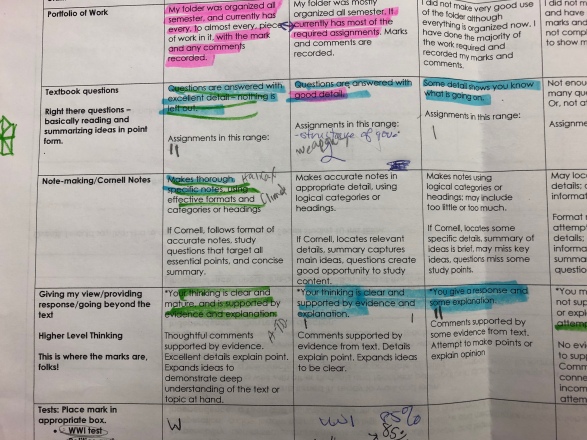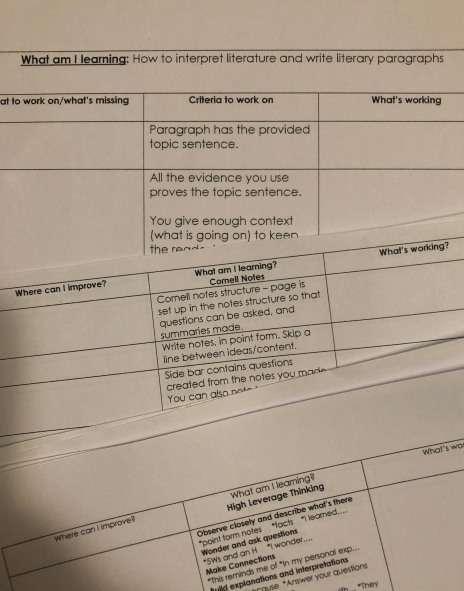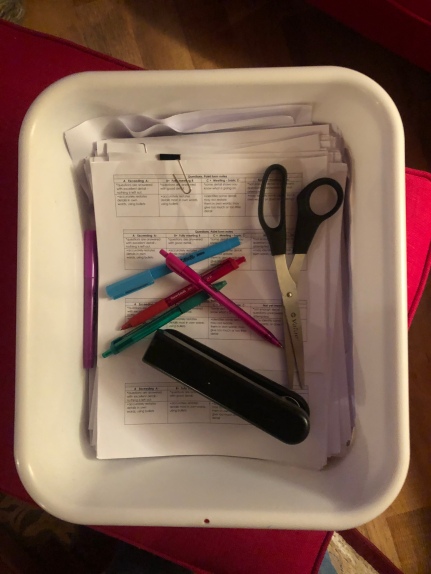Assessment has been one of the trickier aspects of teaching for me. I have experienced a lot of frustration, anxiety, and struggle over the 20-odd years of my career. Through work with my amazing colleagues at Fort St. James Secondary School, some great books and professional development, and my virtual colleagues out in the Twitterverse, I am feeling more and more confident about the assessments I do in my class, and thought I should share it.
Here is a “how assessment works in this class” explainer that each student gets at the beginning of the course.
It’s a process!
Portfolio Assessment
Many teachers in the English and Social Studies Departments at our school use portfolio assessment. This has been a truly collaborative effort over many years. Several teachers have contributed their incredible hard work and effort toward what I am describing below. (Cindy, Misha, Gretchen, Lenore, Marni, Deirde, Kate-Nicola, Karen!)
Each student has a folder with a tracking sheet and all returned work. Once a week, or so, we do a folder check. This means students record recent assignments on their tracking sheet, receive assessed work back from me, and record any marks and comments that were given. I ask them to record comments from me that might help them see both what they are doing well, and what their next steps would be. In this way, they can spot trends. It pushes them to look at what I wrote about their work, not just at what they ‘got’. All work is in the folder, in a bin, and the folder does not leave the room!

I don’t print out computer lists – I don’t have computer lists. If they ask me what they are missing, or what percent they have, I ask them to pull out their folder and to tell me what they think. We check and make sure their tracking sheets are up to date. I let them know that I am happy to sit with them and help them see how they are doing. In our departments, we have worked hard to move the responsibility to them. How they are doing should not be a mystery, or up to the teacher to keep track of.
I used to have different weights for different types of work – classwork, assignments, tests and projects, and the final. Students would often ask, “What is this worth?”
I don’t do that anymore.
The portfolio assessment is holistic, although, the more complex the thinking, the more sophistication in the demonstration of the skill, the more important the mark.
My colleague, Gretchen, shared her work on the process of involving students with assessing their overall performance and arriving at a numerical grade. It is a very important aspect of the ‘what am I learning/how am I doing/what’s next? process. At mid-term and end-of-term, students do a portfolio assessment and give themselves an overall grade. Students transfer all the work from their portfolio from the term onto the larger assessment sheet. I have included one below – there is no standard sheet. All our semesters vary, so the portfolio assessment will vary. You’ve got to have standard rubrics for a variety of types of assignments so that the assessments can transfer onto the larger sheet.
Gretchen is great at conferencing with students one by one. It takes a lot of time. For her English 10, 11, and 12 classes it takes a full four hours at mid-term, and the same number at term end. However, she has found that time critical in moving students forward toward their next goal.
I am less consistent, but working on it. Most often, I chat with them as they work on this document, or I conference with them after. Sometimes, we run out of time for that final conversation. It’s not a perfect world, and I am working on building in the time!

Here is an example of a English 11 – Final Overall Assessment – Student Teacher Evidence-based Conference Prep Sheet I used last year in English 11. This was adapted from Gretchen’s work – so grateful for the collaboration and sharing in our departments!
Another key aspect of our process is the idea of bands of grades. There are only three possible percentages at each grade level.
Most students are bang-on with this self- assessment. A few underestimate themselves, and once in a while, someone will overestimate their performance.
Formative Assessment
Comments only to start
When I am teaching a new skill, I don’t give any type of numerical or rubric-based assessment. I give comments only. It is a constant effort to pull back the damage numerical scores have done. Of course, sometimes there is a number – say, on a key terms quiz. Mostly, however, assignments are assessing comprehension, skills such as note-making, writing, and high leverage thinking.
Three column assessment

Lately I have started to integrate three-column or single point rubric assessment for complex skill – specific types of writing, high-leverage thinking, types of note-making. Again, it stops students from looking at the mark and ignoring what they should be learning from the assessment on how to improve, and on what they are doing well.

Summative assessment
In part, the summative assessment comes from showing what they are learning repeatedly. For skills like finding summarizing text, making point-form notes, finding main ideas and details, or comprehending, students should see a solid trend when they transfer learning over to the mid and final portfolio assessment.

As well, there are larger summative assessments-an inquiry project, an essay, an in-class write or exam, a concept map, or other presentation. These involve more sophisticated skills and often include demonstrating an understanding of the essential questions and big ideas.
The practical aspects
I do a lot of marking at home. When I can, I include the rubric on the assignment to ensure transparency.

Sometimes there is no assignment sheet, and I staple the rubric to the work. Having them all at home is handy!

So, I have a white plastic bin loaded with my most commonly used rubrics, pens, scissors, and a stapler.

I try keep all my rubrics in one document so I can find them easily.
That’s it. I hope there is something useful for you here. If you have any great tricks for the process of assessment, please share them in the comments!

Hi Kelley!! Way to go for taking the step to share your process of moving to a different assessment way of life!!
I would like to share this further if that’s ok. I have some colleagues at McLeod who are unsatisfied with the process they go through for reporting and I think this could provide nuggets of ideas for their change.
I also would like to highlight it through BCTELA Twitter. Is that ok? I haven’t hit Twitter yet this morning but if you’ve tweeted it I’ll retweet. If you haven’t I would like to start it!
I am missing FSJSS this year…People are so busy that there seems to be a pause in formal inquiry (and that’s totally ok) and we are focusing on working with FLESS a bit. Can’t do everything I am learning!. 🙂
Hope to see you sometime in 2nd semester as I learn more through the Ab Ed Lead Teacher project. The reading is inspiring but we are only just beginning. 🙂
Have an awesome day!
Michelle Miller-Gauthier
Thanks, MIchelle – way of life is right! It informs every aspect of teaching and learning. And, we are all still learning. You are always welcome to share widely. My hope is that people might find something that helps – no need for us to all re-invent the wheel. I could also meet with some teachers at McLeod if you’d like. We miss you a lot as well! I hope to work with you in the coming semester – I have a prep and so life is about to reduce to a dull roar, instead of hurricane speed! I always love our conversations. I am doing an inquiry in English 9, Socials 8 and GEO/SR 11/12. Bring it!